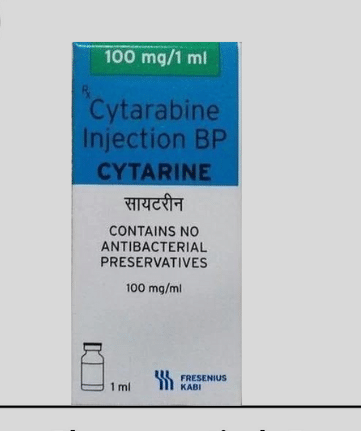Cytarabine 100mg Injection Cytarine
Trade Name: Cytarine
Manufacturer: Fresenius Kabi India Pvt Ltd
Presentation: Injection
Strength: 100mg
What is Cytarabine 100mg Injection used for?
Cytarabine 100mg Injection is used to treat some kinds of leukaemia (cancer of the white blood cells), such as acute myeloid leukaemia (AML), acute lymphocytic leukaemia (ALL), and chronic myelogenous leukaemia (CML), either alone or in combination with other chemotherapy medications (CML).
What type of chemo is cytarabine?
Type of medication: Cytarabine is an anti-cancer chemotherapeutic medication (sometimes known as “antineoplastic” or “cytotoxic”). This drug is referred to as a “antimetabolite.” (See the “How cytarabine Works” section below for further information.)
Why is cytarabine effective in treating cancer?
Cytarabine is a chemotherapy medication. It kills cancer cells by preventing them from creating and repairing DNA, which is required for them to grow and multiply.
Can cytarabine cause fever?
Fever can develop after receiving cytarabine and for up to 24 hours following. Eye drops with large doses of cytarabine may help with conjunctivitis. Children experience more vomiting issues after receiving intrathecal cytarabine than they do after receiving intrathecal methotrexate.
Does cytarabine cause hair loss?
Some persons may experience transient hair loss as a result of this medication. Normal hair growth should resume after the cytarabine medication is finished. To know more click here.
How effective is cytarabine?
Overall survival rates with cytarabine in conventional and high dose regimens are around 40%, with remission rates of 70–80% and relapse-free 5-year survival rates of 40-70 percent [15]. When compared to palliation, standard intensive treatment improves early death rates and long-term survival.
What is the action of cytarabine?
The sugar moiety of cytarabine prevents the molecule from rotating within the DNA. It is a specialised treatment for rapidly dividing cells, such as those seen in cancer, because DNA replication stops during the S phase of the cell cycle.
Where does cytarabine come from?
Four decades ago, the separation of C-nucleosides from the Caribbean sponge Cryptotheca crypta laid the groundwork for the development of cytarabine, the first marine-derived anticancer drug. Cytarabine is being utilised in the treatment of leukaemia and lymphoma patients.
What is cytarabine syndrome?
Cytarabine syndrome is an uncommon clinical disorder marked by fever, malaise, myalgia, arthralgia, and/or rash following cytarabine use. Despite taking preventive dexamethasone, our patient had a fever, malaise, and generalised body discomfort shortly after starting cytarabine.
Does cytarabine cause anaemia?
Reactions that are expected. Because cytarabine is a bone marrow suppressor, it can cause anaemia, leukopenia, thrombocytopenia, megaloblastosis, and decreased reticulocytes. The intensity of these reactions is determined by the dose and time of administration.
How often is cytarabine given?
Intermittent dosing: Cytarabine can be given in five-day intervals as 3-5 mg/kg intravenous doses. This course of treatment can be repeated every 2 to 9 days until the desired therapeutic response or toxicity is achieved.
How does cytarabine affect the skin?
Changes in the skin
Cytarabine might create a rash that is itchy and red. Your skin may get red or blistered as a result of this. Your skin may peel if you take a high dose of cytarabine. Any changes in your skin should always be reported to your doctor or nurse.
Is cytarabine radioactive?
Peak plasma levels of radioactivity are attained about 20 to 60 minutes after subcutaneous or intramuscular delivery of tritium-labelled cytarabine and are significantly lower than those achieved after intravenous treatment.
We are a Global Wholesaler and Exporter from India and Operate in more than 5 Countries like UAE, Oman, Qatar, Saudi, Myanmar, etc. If you are looking for a Product or Brand To Click here.







